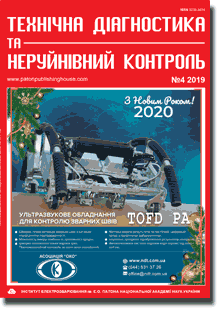| 2019 №04 (01) |
DOI of Article 10.15407/tdnk2019.04.02 |
2019 №04 (03) |

"Tekhnichna Diahnostyka ta Neruinivnyi Kontrol" (Technical Diagnostics and Non-Destructive Testing) #4, 2019, pp. 25-30
Prediction of residual strength of pipeline elements with detected corrosion defects based on Monte-Carlo method
A.S. Milenin, E.A.Velikoivanenko, G.F. Rozynka, N.I. Pivtorak
E.O. Paton Electric Welding Institute of the NAS of Ukraine. 11 Kazymyr Malevych Str., 03150, Kyiv. E-mail: office@paton.kiev.ua
Evaluation of residual strength and performance of pipelines with corrosion defects, found at flaw detection, envisages meeting the limiting state criteria, which correlate the properties of pipe material and actual geometry of the structure with service load system. One of the ways to lower the conservatism of the respective numerical analysis is to directly take into account the natural scatter of physico-mechanical properties of the material. This paper proposes the numerical approach to statistical analysis of the limiting state of pipelines with defects of local thinning of the wall, which is based on consideration of the natural spatial non-uniformity of material properties (such as yield limit, microfracture stress, initial concentration of nuclei porosity of plastic deformation, critical value of plastic deformation, etc.) within the finite-element description of simultaneous development of the stress-strain state and ductile subcritical damage, using Monte-Carlo method. It is shown that this approach is characterized by lower conservatism, compared to generally-accepted deterministic methods, which imply consideration of uniform material properties. Here, statistical analysis remains sufficiently accurate for solving the characteristic problems of technical diagnostics of high hazard facilities. 10 Ref., 2 Tabl., 7 Fig.
Keywords: pipeline, defect of corrosion loss of metal, limiting state, fracture probability, Monte-Carlo method, ductile fracture
Received: 20.09.2019
Published: 11.12.2019
References
1. Bjornoy O.H., Marley M.J. (2001) Assessment of corroded pipelines: Past, Present and Future. Proc. of 11th International Offshore and Polar Engineering Conference. Stavanger, Norway, June 17-22, 1, 93-101.2. (2008) DSTU-N B V.2.3-21:2008: Directive. Definition of residual strength of main pipelines with defects. Kyiv, Minregionbud Ukrainy [in Ukrainian].
3. Bjornoy O. (Ed.). (2004) Recommended Practice, DNV-RP-F101. Corroded Pipelines. Hovik, Det Norske Veritas. https://doi.org/10.1115/IPC2004-0424
4. Milenin O.S. (2017)Numerical prediction of the current and limiting states of pipelines with detected flaws of corrosion wall thinning. Journal of hydrocarbon power engineering, 4(1), 26-37.
5. Velikoivanenko,E.A., Milenin, A.S., Rozynka, G.F., Pivtorak, N.I. (2013 Modelling of processes of nucleation and development of ductile fracture pores in welded structures. The Paton Welding J., 9, 24-29.
6. Makhnenko V. (2013) Problems of examination of modern critical welded structures. The Paton Welding Journal, 5, 21-28.
7. Benallal A., Desmorat R., Fournage M. (2014) An assessment of the role of the third stress invariant in the Gurson approach for ductile fracture. European Journal of Mechanics - A/Solids, 47, 400-414. https://doi.org/10.1016/j.euromechsol.2014.02.009
8. Chen Z., Butcher C. (2013) Micromechanics Modelling of Ductile Fracture. Netherlands, Springer. https://doi.org/10.1007/978-94-007-6098-1
9. Milenin A., Velikoivanenko E., Rozynka G., Pivtorak N. (2019) Probabilistic procedure for numerical assessment of corroded pipeline strength and operability. International Journal of Pressure Vessels and Piping, 171C, 60-68. https://doi.org/10.1016/j.ijpvp.2019.02.003
10. Velikoivanenko E.A., Milenin A.S., Popov A.V. et al. (2014) Methods and technologies of parallel computing for mathematical modeling of stress-strain state of constructions taking into account ductile fracture. Journal of Automation and Information Sciences 46(11), 23-35. https://doi.org/10.1615/JAutomatInfScien.v46.i11.30
The cost of subscription/purchase order journals or individual articles
| Journal/Currency | Annual Set | 1 issue printed |
1 issue |
one article |
| TPWJ/USD | 384 $ | 32 $ | 26 $ | 13 $ |
| TPWJ/EUR | 348 € | 29 € | 24 € | 12 € |
| TPWJ/UAH | 7200 UAH | 600 UAH | 600 UAH | 280 UAH |
| AS/UAH | 1800 UAH | 300 UAH | 300 UAH | 150 UAH |
| AS/USD | 192 $ | 32 $ | 26 $ | 13 $ |
| AS/EUR | 180 € | 30 € | 25 € | 12 € |
| SEM/UAH | 1200 UAH | 300 UAH | 300 UAH | 150 UAH |
| SEM/USD | 128 $ | 32 $ | 26 $ | 13 $ |
| SEM/EUR | 120 € | 30 € | 25 € | 12 € |
| TDNK/UAH | 1200 UAH | 300 UAH | 300 UAH | 150 UAH |
| TDNK/USD | 128 $ | 32 $ | 26 $ | 13 $ |
| TDNK/EUR | 120 € | 30 € | 25 € | 15 € |
AS = «Automatic Welding» - 6 issues per year;
TPWJ = «PATON WELDING JOURNAL» - 12 issues per year;
SEM = «Electrometallurgy Today» - 4 issues per year;
TDNK = «Technical Diagnostics and Non-Destructive Testing» - 4 issues per year.





